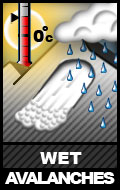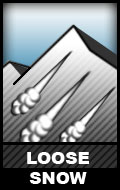Weekend Avalanche Outlook
Issued Friday, April 14, 2017 at 8:45pm. This is a general backcountry (recreational) avalanche advisory for Chugach State Park with the Front Range and South Fork Eagle River areas as the core advisory zones.
Early in the day:
Later in the day:
Avalanche danger will rise throughout the day with increasing temperatures and solar radiation. Be mindful of the sun and temperature’s effect on the snow. Signs of increasing danger include wet loose avalanches from steep solar aspects, rollerballs, and increasing penetration at your feet as the snow becomes wetter. Even where these danger signs do not give warning, beware that warm temperatures can destabilize the snowpack and reawaken persistent slab instabilities.
Make sure you know how to identify avalanche terrain and dangerous avalanche paths that can threaten commonly traveled routes like summer trails (e.g. Crow Pass, Penguin Ridge, Falls Creek, Powerline, Flattop, O’Malley Gully). Warm temperatures may trigger natural avalanches in the upper elevations that can run into the lower elevations and cross terrain and trails that may be flat and even snow free (e.g. Falls Creek).
Practice safe travel protocols, carry necessary personal safety and rescue gear, and leave a trip plan (with emergency response) with someone that is staying in town.
Avalanche Problems:
Natural (especially initiating as point releases from rocky terrain) and human triggered wet loose avalanches up to D2 in size are likely in the afternoon and evening on steep, solar aspects at all elevations. These are likely to be relatively slow moving, but will be heavy and could carry a lot of volume. They will have the potential to injure a person (due to their wet-concrete-like nature), cause a loss of control, and even bury a person in a terrain trap. Be on the lookout for paths that could channel naturally triggered wet loose avalanches; don’t linger around such paths. Also, if traveling around steep rocky terrain on solar aspects (especially if channeled), watch for rockfall triggered by warming.
Wet slab avalanches up to D2.5 in size may be triggered by wet loose avalanches, or a human trigger on a slope after it has become too wet.
Cornices are likely at their peak size for the season and will be subjected to intense radiation and warm temperatures on solar aspects this weekend. This may cause them to fail naturally, or be especially susceptible to failing from the weight of a human.
As always, don’t approach a snowy ridge to look down slope unless you’re sure it’s not corniced. Give corniced ridges a wide berth; they can break back further than expected. Watch for overhead cornice fall hazard on solar aspects and remember that cornice falls pose an inherent hazard, as well as their ability to trigger an avalanche as they “bomb” the slope they fall onto.
Isolated persistent slabs up to D2.5 in size are possible on steep (35*+) terrain above 3000′. Persistent slabs may be triggered by warming on upper elevation solar aspects later in the day. On shady (northerly) aspects, persistent slabs are expected to be the most problematic in upper elevation areas with unsupported terrain features, where there are fatter pockets of wind loaded snow, and where the terrain is harboring persistent weak layers closer to the surface.
Persistent slabs may behave unpredictably (with hard slab characteristics), and could let a human trigger get well on to the slab before releasing above and around – making escape difficult.
Human triggered “sluffs” are possible on steep northerly terrain. These will likely be faster moving, but lower volume, than a wet loose avalanche. These could prove problematic given terrain traps and exposure. While they may not have enough mass to bury a person, they could definitely cause a fall or loss of control.
Mountain Weather:
Sunny with alpine temps from the mid 20s to mid 40s and light wind.
__________
Many avalanche accidents that have happened in Anchorage’s backyard of Chugach State Park could have been prevented by basic avalanche awareness. This level of awareness can be gained through a free or low-cost class. However, there aren’t many opportunities in the spring. If you missed the many offerings earlier this season, make sure you take advantage of the numerous free and low-cost courses that will be offered in the fall. You can start learning with some free online resources here. Getting avalanche education is a big part of recreating safely on your vast and wondrous public land in Alaska, and being able to enjoy the mountains during the snow season will greatly enhance your life.
Here are links to further information on fatal avalanche accidents in Chugach State Park. You can learn from others’ mishaps.
__________
*click avalanche problem icons and hyperlinks for further info





